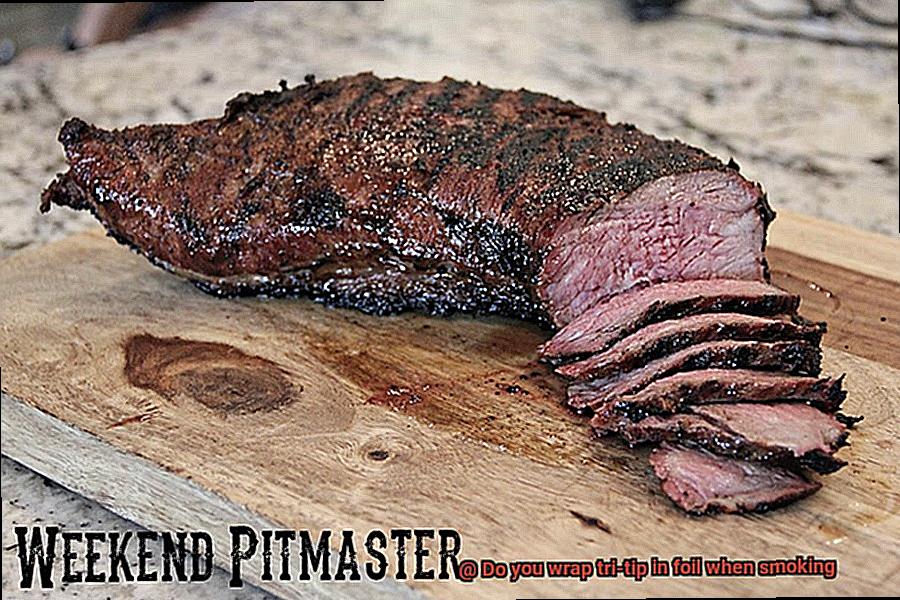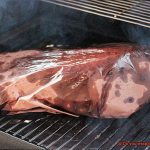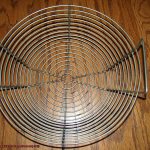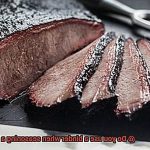Welcome to the tantalizing world of smoking tri-tip, where flavors dance on your palate and every bite is a celebration of smoky goodness.
But amidst the sizzle and smoke, a burning question arises: should you wrap your tri-tip in foil while it’s busy getting its smoky makeover? Fear not, for I am here to guide you through this culinary conundrum.
In this blog post, we’ll embark on a flavor-filled journey into the art of smoking tri-tip, unraveling the mystery behind wrapping it in foil. Prepare yourself for tender, succulent meat that practically melts in your mouth, as we also sprinkle some grilling wisdom along the way.
So, grab your tongs, stoke those coals, and let’s uncover the secrets to perfectly smoked tri-tip.
Contents
What is the Texas Crutch Technique?
This popular method, originating from the heart of barbecue country, is a game-changer when it comes to achieving tender, juicy, and flavorful meat. In this article, we’ll dive deep into the technique, exploring its benefits, potential drawbacks, and tips for perfect execution.
Understanding the Texas Crutch Technique:
The Texas Crutch Technique involves wrapping the meat in foil during the smoking process. This method is particularly useful for tough cuts like brisket, pork shoulder, and ribs that require longer cooking times.
Benefits of the Texas Crutch Technique:
- Moisture Retention: Wrapping the meat in foil creates a sealed environment that helps retain moisture. This prevents the meat from drying out, resulting in a juicier end product.
- Accelerated Tenderizing: The foil acts as a barrier, trapping heat and moisture inside. This creates a steam-like environment that aids in breaking down tough connective tissues and rendering fat, making the meat more tender.
- Control and Consistency: The foil provides a more consistent and controlled cooking environment within the smoker. It helps prevent temperature fluctuations and ensures even cooking throughout.
Potential Drawbacks:
- Softened Bark: Extended exposure to steam inside the foil can soften the bark or crust that forms on the surface of the meat.
- Limited Smoke Absorption: Wrapping the meat in foil reduces its exposure to smoke, potentially affecting the depth of smoky flavor.
Tips for Perfect Execution:
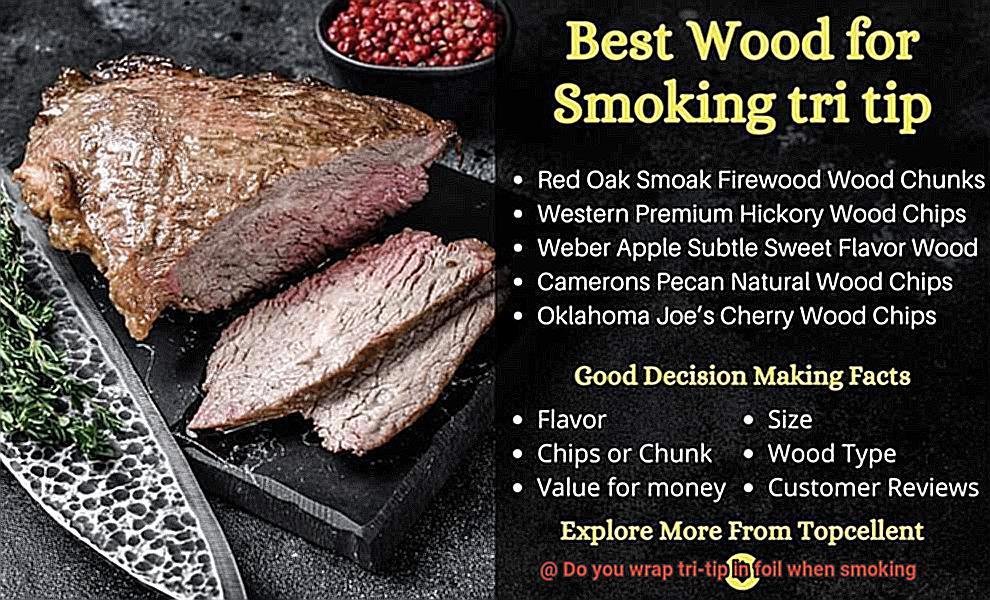
Seasoning: Ensure the meat is properly seasoned with a dry rub or marinade before smoking.
- Timing: After a few hours of smoking, when the meat has developed enough smoke flavor and reached a certain temperature, tightly wrap it in foil.
- Foil Quality: Opt for heavy-duty aluminum foil to prevent tearing or puncturing during the cooking process.
- Double-Wrapping: Consider double-wrapping the meat in foil for added protection against leaks.
- Expansion Room: Leave some space within the foil packet to accommodate expansion as the meat cooks and releases steam.
- Monitor Internal Temperature: Even when wrapped, use a meat thermometer to monitor the internal temperature.
- Foil wrapping creates a barrier that locks in moisture, ensuring your tri-tip stays juicy and succulent throughout the smoking process.
- No more worrying about dry meat; every bite will be bursting with flavor.
- Foil wrapping facilitates consistent heat distribution, eliminating overcooked or undercooked sections.
- Say goodbye to uneven grilling; every slice will be cooked to perfection.
- The Texas Crutch Technique, involving foil wrapping, breaks down collagen in the meat for a melt-in-your-mouth tenderness.
- Prepare to impress your guests with a tri-tip that practically dissolves on their tongues.
- Foil trapping smoke and aroma from wood chips or charcoal infuses your tri-tip with a delightful smoky flavor.
- Each mouthwatering bite will transport your guests to BBQ heaven.
- Foil wrapping contains drippings and marinade, making cleanup effortless.
- Spend more time savoring your delicious tri-tip and less time scrubbing grates.
- Foil’s insulating properties speed up cooking by reflecting heat back onto the meat, allowing you to enjoy your tri-tip sooner.
- No need to sacrifice flavor or tenderness; indulge in perfectly cooked tri-tip without the wait.
Benefits of Wrapping Tri-Tip in Foil
By harnessing the power of foil wrapping during the smoking process, you can elevate your tri-tip game and leave your guests in awe. In this blog post, we’ll explore the numerous benefits of foil wrapping and provide expert tips for achieving perfect results.
Retains Moisture:
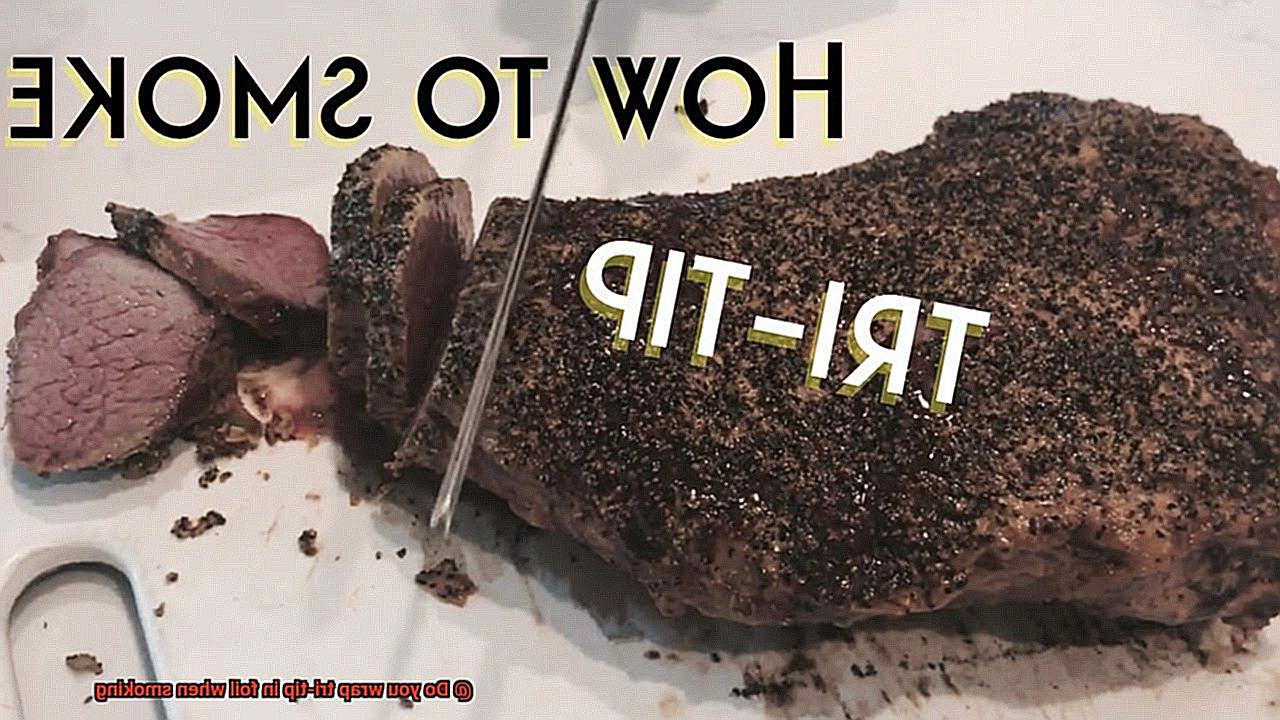
Even Heat Distribution:
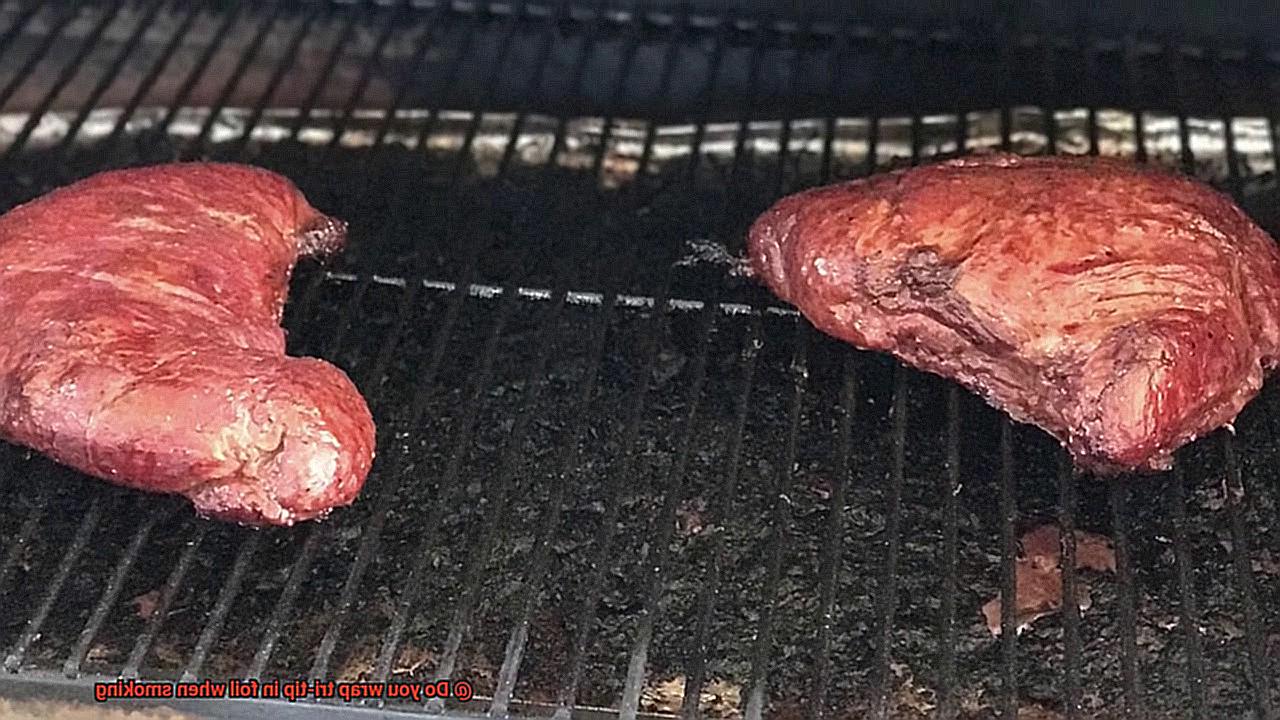
Enhanced Tenderness:
Flavor Infusion:
Easy Cleanup:
Reduced Cooking Time:
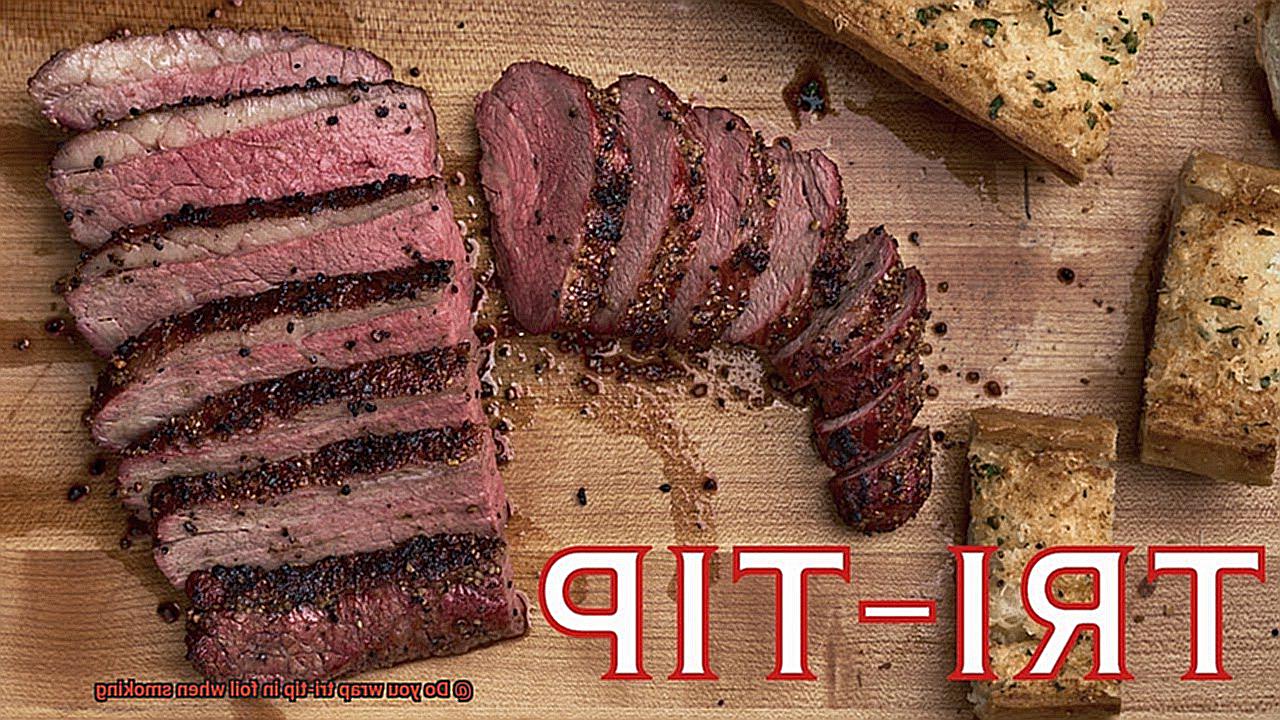
Arguments Against Wrapping Tri-Tip in Foil
Before you reach for that roll of foil to wrap up your tri-tip, consider the arguments against this technique. While foil may seem like a convenient option, it can actually result in an undesired texture, flavor, and appearance for your smoked tri-tip.
First, let’s talk about texture. Wrapping tri-tip in foil creates a steamed cooking environment, which can lead to a softer and less crispy crust on the meat. Say goodbye to that perfect smoky flavor with a nice bark or crust – foil acts as a barrier between the meat and the smoke, preventing the formation of that flavorful and caramelized exterior.
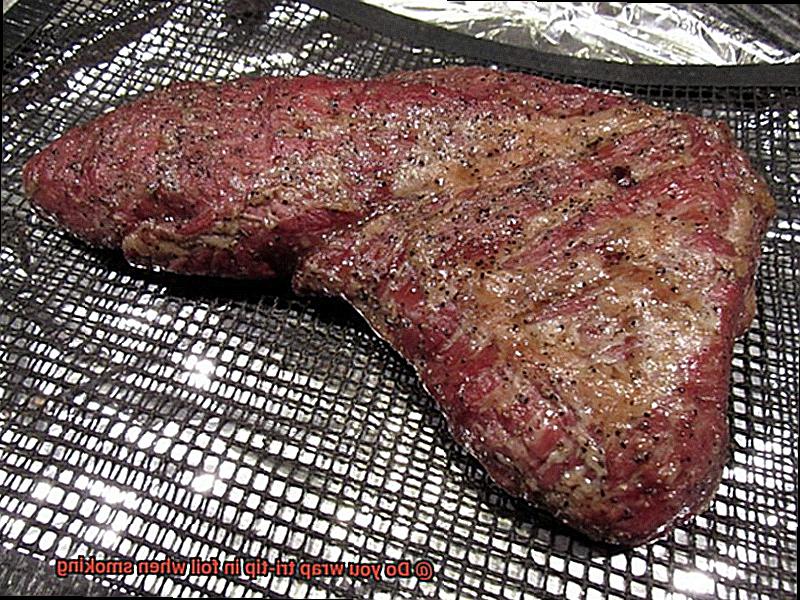
But it’s not just about texture – flavor is also affected. Foil can impede the absorption of smoky flavors from the wood chips or charcoal. Without direct exposure to the smoke, your tri-tip may lack that distinct smoky taste that we all crave when smoking meat.
Now, let’s address doneness. Wrapping tri-tip in foil can make it more difficult to achieve a medium-rare or medium doneness. The trapped heat and moisture in the foil can lead to overcooking, resulting in a well-done tri-tip that lacks juiciness.
Texture is another concern. Extended cooking time within the foil can break down the connective tissues too much, resulting in an overly tender or mushy tri-tip. And let’s not forget about seasonings and marinades – with foil wrapping, it becomes challenging to enhance the flavor profile of your tri-tip as you don’t have direct access to the meat’s surface.
Lastly, visual appearance matters too. Wrapping tri-tip in foil eliminates the opportunity for the meat to develop a good color. The direct exposure to heat and smoke without any barriers creates an appealing visual appearance on the tri-tip.
Tips for Wrapping Tri-Tip in Foil
Wrapping tri-tip in foil while smoking is a popular technique that guarantees extra juicy and tender meat. In this comprehensive guide, we’ll take you through the steps and share insider tips for a mouthwatering outcome every time.
Step 1: Season with Love
Before wrapping the tri-tip in foil, infuse it with flavor. Sprinkle your favorite spices and marinades generously to create a tantalizing taste profile that will enhance the meat’s natural flavors.
Step 2: Wrap it Tight
Once seasoned to perfection, tightly encase the tri-tip in heavy-duty aluminum foil. This creates a steamy environment that locks in moisture, resulting in incredibly succulent meat that melts in your mouth.
Step 3: Seal the Deal
To ensure no steam escapes, fold the edges of the foil tightly together or use a double layer of foil for added protection. This seals in all those amazing flavors, creating a flavorful and tender final product.
Step 4: Cooking Time Matters
The duration of wrapping depends on your desired level of doneness. For medium-rare tri-tip, wrap it when it reaches an internal temperature of approximately 140°F (60°C). Use a reliable meat thermometer to be certain.
Step 5: Unwrap and Savor
Once the tri-tip reaches your desired temperature, remove it from the foil and let it rest for at least 10 minutes before slicing. This crucial step allows the juices to redistribute within the meat, resulting in a tender and flavorful outcome.
Factors to Consider When Deciding Whether or Not to Wrap Tri-Tip in Foil
The decision of whether or not to wrap your tri-tip in foil during the cooking process is a crucial one. It may seem like a simple choice, but there are several factors to consider that can greatly impact the flavor, texture, and overall success of your smoked tri-tip.
First and foremost, cooking time should be taken into account. If you’re short on time and eager to get that tri-tip on the table as quickly as possible, wrapping it in foil can be a game-changer. The foil acts as an insulator, trapping heat and moisture around the meat and speeding up the cooking process. However, if you’re a fan of low and slow cooking, where flavors have time to develop and intensify, then ditching the foil might be your best bet.
Moisture retention is another important consideration. Wrapping your tri-tip in foil creates a sealed environment that helps prevent moisture loss, resulting in a juicier and more tender final product. This is especially beneficial if you’re working with leaner cuts of tri-tip that have a tendency to dry out easily. However, if you prefer a drier exterior or want to achieve a more intense smoke flavor, skipping the foil can give you the desired results.
What about bark formation? The bark is that deliciously flavorful crust that forms on the outside of smoked meats. If you’re a fan of a thick and crunchy bark, then cooking your tri-tip without foil is the way to go. Foil creates a moist environment that inhibits bark formation, so if you’re after that perfect balance between tender meat and a crispy exterior, skip the foil.
Smoke penetration is another factor to consider. Foil can act as a barrier between the smoke and your tri-tip, resulting in a milder smoke flavor. If you love that strong and pronounced smoky taste, then cooking without foil is the way to achieve it. Direct exposure to the smoke will infuse your tri-tip with that unmistakable smokiness that we all crave.
Texture is also affected by the decision to wrap or not to wrap. Cooking without foil allows for more direct heat exposure, resulting in a crispier exterior and potentially a more pronounced temperature gradient throughout the meat. On the other hand, using foil creates a gentler cooking environment that can yield a more even and tender texture throughout the tri-tip.
Ultimately, the decision to wrap or not to wrap your tri-tip in foil when smoking comes down to personal preference. Experimenting with both methods can help you determine which approach aligns best with your desired flavor profile and texture. Consider your taste preferences, as well as the specific characteristics of the tri-tip cut you’re working with, such as thickness and marbling.
Pros and Cons of Wrapping Tri-Tip in Foil
Well, prepare to be tantalized by the pros and cons that will help you make an informed decision.
Let’s dive into the advantages. Wrapping tri-tip in foil is like a moisture fortress. The foil acts as a shield, preserving those precious natural juices and preventing them from evaporating during the cook. Bid farewell to dry meat and say hello to a succulent and juicy tri-tip.
But wait, there’s more. Foil wrapping can work wonders for your cooking time. By enclosing the meat, it creates an “oven-like” ambiance, ensuring even and efficient heat distribution. Perfect for those moments when you’re pressed for time but still crave that smoky goodness.
Tenderizing is another perk of foil wrapping. The trapped steam and moisture inside work their magic, breaking down tough connective tissues, resulting in a melt-in-your-mouth tenderness that will leave your taste buds singing.
And let’s not forget about convenience. Wrapping your tri-tip in foil makes handling and transporting a breeze. No more messy drippings or falling-apart meat. The foil acts as a protector, keeping everything intact and ready for your next backyard barbecue or picnic.
Now, let’s explore the flip side. One concern with foil wrapping is that it may hinder the development of a delectable bark or crust on your tri-tip. The moisture trapped close to the surface prevents that crispy and caramelized goodness from forming. If a bark is high on your priority list, you might want to reconsider.
Another drawback is the potential reduction of smoky flavor. The foil acts as a barrier between the meat and the smoke, limiting the amount of smokiness that can infuse into the meat. If you crave that robust smoky taste, this could be a dealbreaker.
Last but not least, wrapping tri-tip in foil can sometimes result in a softer texture. The enclosed environment creates steam, giving the meat a tender bite. However, some prefer a firmer texture to their tri-tip.
Alternatives to Wrapping Tri-Tip in Foil
While wrapping tri-tip in foil is a popular method for keeping it moist and flavorful, there are alternatives that can give you similar results without sacrificing that delectable bark. Get ready to explore some exciting options.
First up, we have the versatile butcher paper. This food-grade paper is a game-changer. It allows smoke and heat to penetrate your tri-tip while still retaining moisture. Simply wrap your tri-tip tightly in the paper, ensuring all sides are covered, and let it cook to perfection. The butcher paper acts as a protective barrier, keeping those precious juices locked in while allowing for a nice crust to develop. It’s like magic happening right before your eyes.
Next on the list is the trusty drip pan. This disposable aluminum tray is a true hero. Place it beneath your tri-tip while it cooks, and watch as it catches any drippings, preventing them from evaporating and drying out the meat. By keeping those juices close to the tri-tip, you create a moist cooking environment that will result in a tender and juicy end product. It’s like having a secret sauce of flavor right under your nose.
Now, let’s talk marinades and brines. These flavor powerhouses are not only delicious but also help keep your tri-tip moist during the smoking process. Marinating or brining your meat before smoking can work wonders. The proteins break down, tenderizing the meat and resulting in a juicy and flavorful tri-tip. It’s like an explosion of flavors dancing on your taste buds.
Whether you choose butcher paper, drip pans, or marinades/brines, the key is to experiment and find what works best for you. Say goodbye to foil and hello to tantalizing flavors and mouthwatering textures.
RI42rw4N92Q” >
Conclusion
In conclusion, the decision of whether to wrap tri-tip in foil when smoking is a matter of personal preference and desired outcome. The Texas Crutch Technique, also known as wrapping tri-tip in foil, offers a range of benefits that can elevate your smoking experience. It locks in moisture, speeds up tenderization, ensures consistent cooking, and simplifies cleanup. Additionally, it infuses the meat with delectable flavors while reducing overall cooking time.
However, there are valid arguments against using foil to wrap tri-tip. Foil has the potential to soften the coveted bark or crust on the meat, hinder smoke absorption, complicate achieving desired doneness, and impact both texture and visual appeal.
To achieve optimal results when wrapping tri-tip in foil, follow these expert tips: season your meat generously beforehand, opt for heavy-duty aluminum foil for added durability, double-wrap to prevent any pesky leaks from spoiling your cookout extravaganza, leave room for expansion within the foil packet to avoid unwanted pressure build-up, and keep a close eye on the internal temperature by using a reliable meat thermometer.
When making your decision about whether or not to wrap tri-tip in foil during smoking sessions, consider crucial factors such as cooking time requirements, moisture retention priorities, bark formation preferences, smoke penetration goals, and desired texture outcomes. Remember that alternatives like butcher paper, drip pans or experimenting with marinades/brines can offer unique twists on traditional foil-wrapping techniques.
Ultimately though, it’s vital to embark on a culinary adventure of trial and error to discover what suits your taste buds best and complements the specific cut of tri-tip you’re working with. Whether you choose to embrace the enveloping embrace of foil or venture into uncharted territory without it when smoking tri-tip – aim high. Strive to create an irresistible masterpiece that leaves your guests astounded by its tenderness and flavor explosion.

